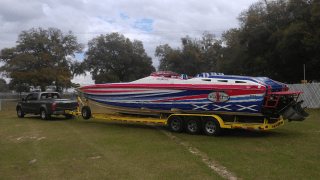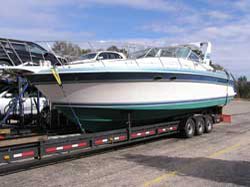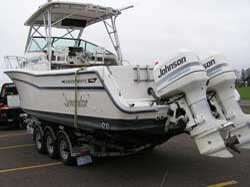Powerboat Transport Preparation Guide
Here we answer some of the most commonly asked questions about the advance preparations needed before your powerboat transport is ready to commence. A lot of it is really just general common sense, although like most things, paying attention to all the small details is important in getting your powerboat transportation job done right. We are capable of handling all the details related to the logistics of moving your powerboat. These steps are part of what you will need to do, or have your powerboat transportation company do for you before pick up of your vessel. All powerboats have their own personality and quirks. The understanding of these quirks is critical in making sure your vessel is transported safely to its new location. If you have questions or concerns, feel free to contact us, as we can be a wealth of information if you are in need of transporting your powerboat.
Hauling your Powerboat and Prep for your Powerboat Transportation Company
To start, you need to thoroughly clean the bottom of your vessel to remove all grasses and living organisms. Using a pressure washer when the boat is placed on the travel lift is usually the best time to clean the bottom. Some states have very strict laws pertaining to the moving of organisms and/or live plants, whether it is into or out of the state. Some states will inspect the boat bottom upon arrival, to make sure all organic matter and organisms have been removed, before allowing the vessel to enter their state. Powerboat haulers usually do not have the equipment on-hand to prep your boat in this manner.
Some Items Need To Be Removed From Your Vessel
All equipment and attachments that travel poorly should to be removed prior to transport. This includes anchors, canvas, antennas, Ventura and any unsecured items in the cockpit and/or bridge areas. Electronic heads need to be stowed in a locker below. Ventura with solid frames should be removed. They can sustain wind damage traveling at 55+mph, creating cracks around the fastening holes, which can be costly to repair. Taping or lashing antennas will stop movement and damage, and as TV antennas are particularly fragile they should be removed and securely lashed below deck. Again, powerboat shipping company drivers typically do not carry tools to prepare your boat in this manner.
Boat Haulers And Height Issues


Water And Fuel Issues and your Powerboat Shipping Company
Fluids can be an issue for boat haulers when moving your vessel. Water and fuel may have to be drained, which should be a normal procedure anyway, especially if the vessel is of wood construction.
We hope we have answered many of your questions about hauling your powerboat. Most of this information can be used when transporting a yacht as well. Powerboat haulers and your powerboat transportation company need to make sure that your boat, their rig and others on the road are safe. If you still have questions or concerns, give us a call and we’ll be happy to help.

